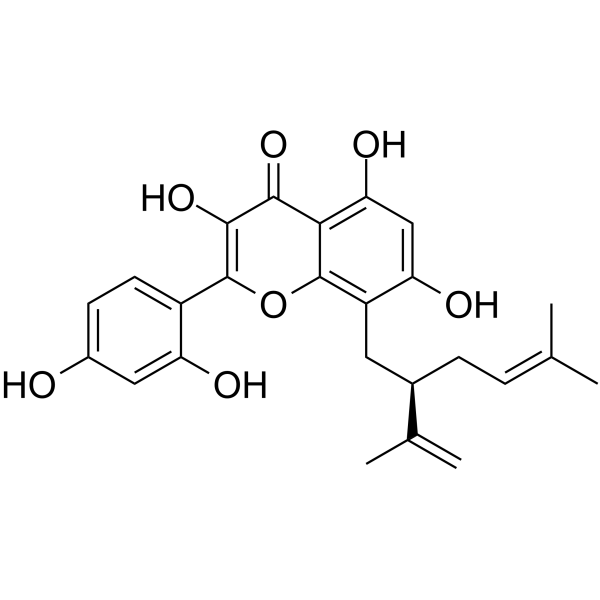
Kushenol C
CAS No. 99119-73-0
Kushenol C( —— )
Catalog No. M31269 CAS No. 99119-73-0
Kushenol C is a good 1,1-diphenyl-2-picrylhydrazyl (DPPH) scavenger, and it exhibits inhibitory activity against Sodium-dependent glucose cotransporter 2(SGLT2).
Kushenol C is a good 1,1-diphenyl-2-picrylhydrazyl (DPPH) scavenger, and it exhibits inhibitory activity against Sodium-dependent glucose cotransporter 2(SGLT2).
Purity : >98% (HPLC)
 COA
COA
 Datasheet
Datasheet
 HNMR
HNMR
 HPLC
HPLC
 MSDS
MSDS
 Handing Instructions
Handing Instructions
| Size | Price / USD | Stock | Quantity |
| 5MG | 567 | In Stock |


|
| 50MG | Get Quote | In Stock |


|
| 100MG | Get Quote | In Stock |


|
Biological Information
-
Product NameKushenol C
-
NoteResearch use only, not for human use.
-
Brief DescriptionKushenol C is a good 1,1-diphenyl-2-picrylhydrazyl (DPPH) scavenger, and it exhibits inhibitory activity against Sodium-dependent glucose cotransporter 2(SGLT2).
-
DescriptionKushenol C is a good 1,1-diphenyl-2-picrylhydrazyl (DPPH) scavenger, and it exhibits inhibitory activity against Sodium-dependent glucose cotransporter 2(SGLT2). Kushenol C shows antimicrobial activity against Staphylococcus aureus and Streptococcus mutans. Kushenol C may be potent preventive and therapeutic candidates for Alzheimer's disease, it (IC(50) 5.45 microM) can inhibit beta-site APP cleaving enzyme 1 (BACE1) activities.
-
In VitroKushenol C dose-dependently suppresses the production of inflammatory mediators, including NO, PGE2, IL-6, IL1β, MCP-1, and IFN-β in LPS-stimulated RAW264.7 macrophages. Kushenol C (50-100 μM;) significantly decreases the phosphorylation of both STAT1 molecules and STAT6 in a dose-dependent manner in LPS-stimulated RAW264.7 cells.Kushenol C upregulates the expression of HO-1 and its activities in the LPS-stimulated RAW264.7 macrophages. In HaCaT cells, Kushenol C prevents DNA damage and cell death by upregulating the endogenous antioxidant defense system involving glutathione, superoxide dismutase, and catalase, which prevents reactive oxygen species production from tert-butyl hydroperoxide (tBHP)-induced oxidative stress in HaCaT cells.
-
In Vivo——
-
Synonyms——
-
PathwayOthers
-
TargetOther Targets
-
Recptor——
-
Research Area——
-
Indication——
Chemical Information
-
CAS Number99119-73-0
-
Formula Weight438.5
-
Molecular FormulaC25H26O7
-
Purity>98% (HPLC)
-
Solubility——
-
SMILES——
-
Chemical Name——
Shipping & Storage Information
-
Storage(-20℃)
-
ShippingWith Ice Pack
-
Stability≥ 2 years
Reference
molnova catalog



related products
-
Troxerutin
Troxerutin, a natural bioflavonoid isolated from Sophora japonica., has been reported to have many benefits and medicinal properties.
-
Buserelin Acetate
Buserelin Acetate is an agonist of gonadotropin-releasing hormone receptor(GnRHR).
-
19-Hydroxybufalin
19-Hydroxybufalin is a natural product, inhibits epithelial-mesenchymal transition and attenuates the migration and invasion of PC3 cells.



 Cart
Cart
 sales@molnova.com
sales@molnova.com


